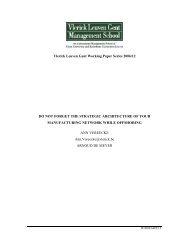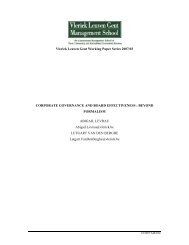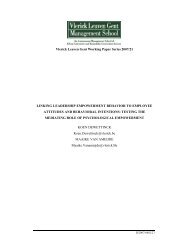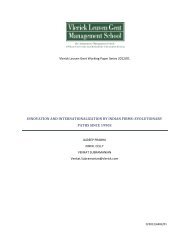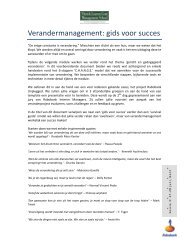an experimental investigation of the interactions ... - Vlerick Public
an experimental investigation of the interactions ... - Vlerick Public
an experimental investigation of the interactions ... - Vlerick Public
You also want an ePaper? Increase the reach of your titles
YUMPU automatically turns print PDFs into web optimized ePapers that Google loves.
Our <strong>the</strong>oretical reasoning assumes that employees will first consider <strong>the</strong> formal mech<strong>an</strong>isms<strong>an</strong>d only consult <strong>the</strong> descriptive social norms when <strong>the</strong> combination <strong>of</strong> formal mech<strong>an</strong>isms ismisaligned. A decision-making strategy in which <strong>the</strong> decision-maker begins by identifying <strong>the</strong> mostimport<strong>an</strong>t dimension <strong>an</strong>d only considers o<strong>the</strong>r dimensions if <strong>the</strong> first dimension does not lead to aclear decision is called a lexicographic decision-making strategy. Such a strategy is <strong>of</strong>ten used indecisions that have multiple dimensions (Plous 1993). The assumption that <strong>the</strong> formal mech<strong>an</strong>ismsare <strong>the</strong> most import<strong>an</strong>t dimension is consistent with Messick (1999) who posits that <strong>the</strong> underlyingeconomic structure <strong>of</strong> a situation is <strong>the</strong> most import<strong>an</strong>t cue to categorize <strong>the</strong> situation <strong>an</strong>d todetermine appropriate behavior. Fur<strong>the</strong>rmore, individuals that enter a firm are <strong>of</strong>ten first informedabout <strong>the</strong> formal mech<strong>an</strong>isms by me<strong>an</strong>s <strong>of</strong> <strong>the</strong>ir contract or during information meetings about <strong>the</strong>working procedures.Thus, employees confronted with a misaligned combination <strong>of</strong> formal mech<strong>an</strong>isms will beconfused about <strong>the</strong> expected behavior <strong>an</strong>d look for a more solid base for decision-making. This willmake <strong>the</strong> descriptive social norms more salient <strong>an</strong>d a more import<strong>an</strong>t driver <strong>of</strong> employee behavior.Conversely, it is less likely that employees confronted with aligned combinations <strong>of</strong> formalmech<strong>an</strong>isms will be confused <strong>an</strong>d this will restrain <strong>the</strong>m from consulting <strong>the</strong> descriptive social norms.This results in <strong>the</strong> following hypo<strong>the</strong>sis:H2: The influence <strong>of</strong> descriptive social norms on <strong>the</strong> degree to which employee decisions arein <strong>the</strong> best interest <strong>of</strong> <strong>the</strong> firm will be larger for aligned combinations <strong>of</strong> formal mech<strong>an</strong>ismsth<strong>an</strong> for misaligned combinations <strong>of</strong> formal mech<strong>an</strong>ismsH1 <strong>an</strong>d H2 are graphically represented in Figure 1. As predicted by H1, <strong>the</strong> degree to whichemployee decisions are in <strong>the</strong> best interest <strong>of</strong> <strong>the</strong> firm is lower when <strong>the</strong> combination <strong>of</strong> formalmech<strong>an</strong>isms is misaligned compared to aligned combinations <strong>of</strong> formal mech<strong>an</strong>isms. Following H2,<strong>the</strong> variation in descriptive social norms will lead to a difference between misaligned combinations <strong>of</strong>formal mech<strong>an</strong>isms but not between aligned combinations <strong>of</strong> formal mech<strong>an</strong>isms.Insert Figure 1 About Here11



